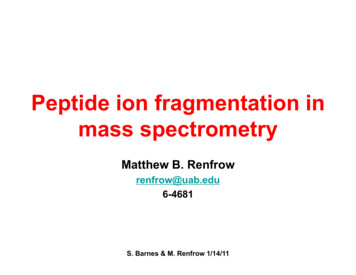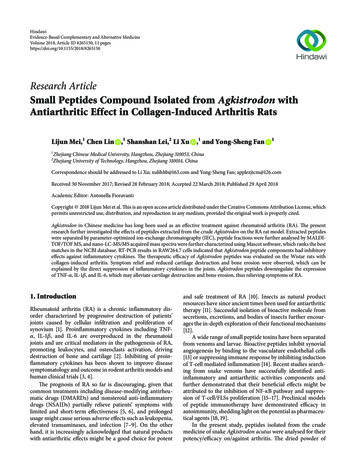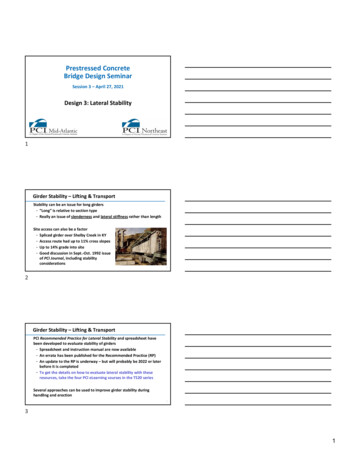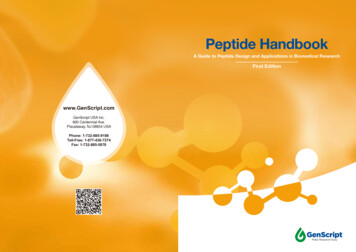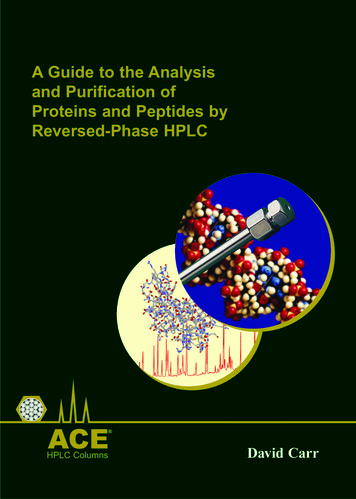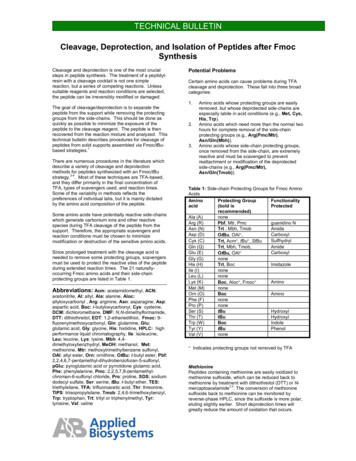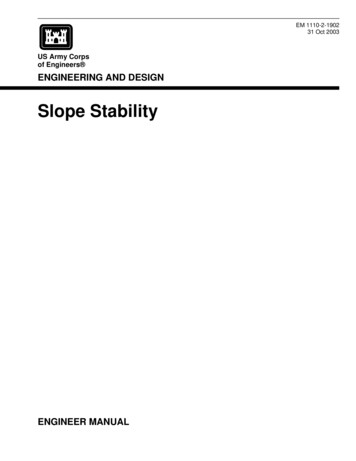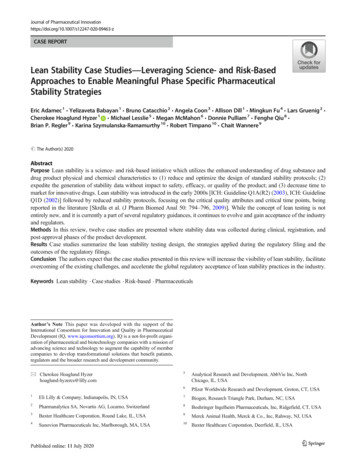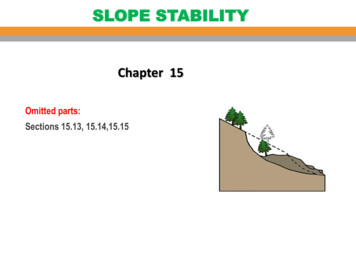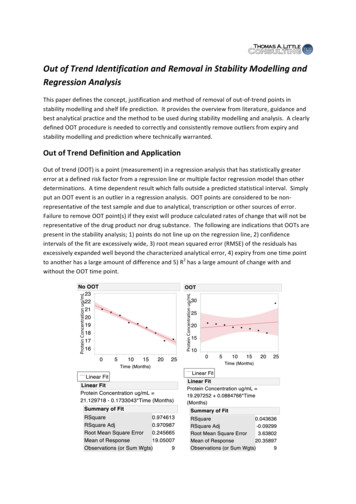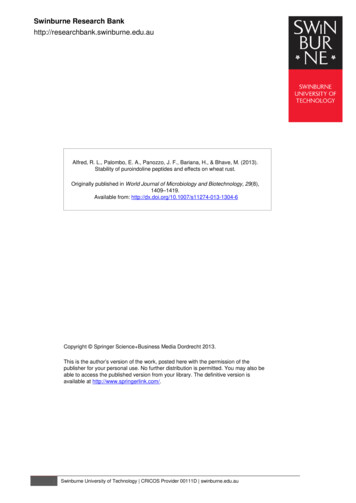
Transcription
Swinburne Research Bankhttp://researchbank.swinburne.edu.auAlfred, R. L., Palombo, E. A., Panozzo, J. F., Bariana, H., & Bhave, M. (2013).Stability of puroindoline peptides and effects on wheat rust.Originally published in World Journal of Microbiology and Biotechnology, 29(8),1409–1419.Available from: ht Springer Science Business Media Dordrecht 2013.This is the author’s version of the work, posted here with the permission of thepublisher for your personal use. No further distribution is permitted. You may also beable to access the published version from your library. The definitive version isavailable at http://www.springerlink.com/.Swinburne University of Technology CRICOS Provider 00111D swinburne.edu.au
STABILITY OF PUROINDOLINE PEPTIDES AND EFFECTS ON WHEAT RUSTRebecca L. Alfreda, Enzo A. Palomboa, Joseph F. Panozzob, Harbans Barianac andMrinal Bhavea*aEnvironment and Biotechnology Centre, Faculty of Life and Social Sciences,Swinburne University of Technology, PO Box 218, Melbourne, Victoria 3122, AustraliabDepartment of Primary Industries, Horsham, Victoria 3400, AustraliacUniversity of Sydney Plant Breeding Institute-Cobbitty, PMB4011, Narellan, NSW2567,Australia*Corresponding author:Mrinal BhaveTel: 61-3-9214-5759;Fax: 61-3-9819-0834E-mail: mbhave@swin.edu.au1
AbstractPeptides modelled on the tryptophan rich domain (TRD) for puroindolines and the relatedGrain Softness Protein-1 have a broad range of antibacterial and antifungal activities. Withthe aims of further investigating the activities of these antimicrobial peptides we studied theiractivity against wheat rust diseases and environmental stability. PINA-based peptides werefound to have high pH and thermal stability in addition to being stable over long periods atroom temperature. These properties could make them excellent candidates as preservativesin food. PuroA, Pina-R39G and PuroB peptides adversely affected the morphology of thestripe rust spores (Puccinia striiformis f. sp. tritici), while PuroA and PuroB showedmoderate inhibition of their germination. Additionally, GSP-5D reduced the germination ofleaf rust spores (P. triticina). PuroA and PuroB spayed onto stripe rust infected plantseffected a moderate reduction in the number of stripe rust uredinia on wheat seedlings, as didPuroB sprayed onto the seedlings and allowed to coat the leaves for 5 day prior to sporeinfection.The results suggest that the presence of the PIN-based peptides may lowerfrequency of initial infection foci.Key wordsAntimicrobial peptides; Puroindolines; Grain Softness Protein-1; wheat rust; Pucciniastriiformis; Puccinia triticina2
IntroductionAntimicrobial peptides (AMPs) are a form of innate defence against pathogen attack in manyorganisms. Resistance to conventional antibiotics by microorganisms is an ever-increasingproblem, and AMPs offer a viable alternative due to their broad spectrum activity and lowpotential for development of resistance (Hancock and Sahl, 2006). AMPs are typicallycomposed of 12-60 amino acid residues, amphipathic, cationic and often have a highproportion of hydrophobic residues (Shai and Oren, 2001). Cationic AMPs are often highlyselective towards bacterial and fungal membranes due to their negatively charged phospholipid headgroups, compared to the zwitterionic headgroups of plant and animal membranelipids. The antimicrobial activity of such peptides is suggested to involve ionic interactionsbetween their basic residues and the negatively charged phospholipid headgroups, and alsopossibly the lipopolysaccharides and teichoic acid of microbial membranes, followed bymembrane permeabilisation by various mechanisms (reviewed in Shai, 2002; Jenssen et al.,2006).The Puroindoline-a (Pina) and Puroindoline-b (Pinb) gene transcripts and puroindoline(PIN) proteins have been shown to be expressed only in developing wheat seeds, leading tothe hypothesis that the in planta roles of PINs might involve defending the seed and youngplant against microbial pathogens (Blochet et al., 1993). The microbial membrane interactionrequired for this effect most likely occurs via the lipid-binding properties of PINs (Blochet etal., 1993). These properties may also be central to the association of PIN proteins with starchgranule membranes and effects on wheat grain texture (Wanjugi et al., 2007; reviewed inBhave and Morris 2008a, b; Kim et al., 2012b). PINs are reported to exhibit antimicrobialactivity in vitro against several bacteria and fungi (Dubreil et al., 1998; Capparelli et al.,2005; Miao et al., 2012) and transgenic plant work has confirmed their causative association3
with antibacterial and antifungal effects (Krishnamurthy et al., 2001; Faize et al., 2004; Luoet al., 2008; Kim et al., 2012a).The synthetic 13-residue peptide PuroA(FPVTWRWWKWWKG-NH2), based on the signature motif called the ‘tryptophan richdomain’ (TRD) of PINA, was identified as the bactericidal domain (Jing et al., 2003). PuroAbinds strongly to membranes with negatively charged phospholipid head-groups. Its lowhaemolytic activity towards mammalian cells (Jing et al., 2003) suggests high selectivity forbacterial membranes, a feature shared with wild-type PIN proteins (Capparelli et al., 2007).Single naturally occurring mutations at the TRD of PINB (Gly46Ser and Trp44Arg) whichhave been associated with hard grain texture, were found to have a decreased selectivitytowards anionic phospholipids (Clifton et al., 2007), and would likely decrease theantimicrobial activity. It has also been proposed that the Arg residue(s) adjacent to the Trpresidue(s) in the TRD may influence the biochemical properties of the Trp and enhance theirmembrane insertion (Jing et al., 2003). If this applies, the 5 Trps and the adjacent Arg inPINA could result in more potent disruption of microbial membranes compared to PINBwhich has only 3 Trps and a Lys instead of Arg (Gautier et al., 1994).However, nosystematic analysis has been conducted testing the relevance of the Trp and/or Arg residueswithin the TRD to the antimicrobial properties.The distantly related protein, grain softness protein-1 (GSP-1), encoded by the Gsp-1 genes,also has a highly similar structure, except for a TRD comprised of only two Trps (Rahman etal., 1994). However, there is no strong evidence for this protein in controlling grain texture,and neither has it been assessed for antimicrobial activity. Orthologs of Pin genes also occurin other Triticeae members e.g., oat (avenoindolines) and rye (secaloindolines) (Gautier et al.,2000) and barley (hordoindolines) (Darlington et al., 2001). There is little research at presenton the textural differences in rye or oats. However, the textural difference in barley is of4
significant commercial interests in beer production. The grains of soft-textured maltingquality cultivars are considered better suited for malting (Brennan et al., 1996; Psota et al.,2007).The hordoindolines (HINs) have been implicated in endosperm textural control(Beecher et al., 2002; Turuspekov et al., 2008; Galassi et al., 2012), and confirmed when anhordolindoline b-2 null mutant was found associated with increased hardness (Takahashi etal., 2010).We have recently shown that a number of peptides with sequences based on the TRD of PINsand HINs are active against bacteria and phytopathogenic fungi (Phillips et al., 2011).However, they have not been tested against the major cereal pathogen causing rust diseases(Puccinia species) which can lead to significant loss of yield. This work explores the effectsof the Pin-based peptides on two main rust diseases of wheat to enhance our understanding ofthe membrane-binding ability of these proteins, an aspect which is intricately related to theirfood technological applications and possibly any in-vivo roles.Materials and methodsDesign and synthesis of peptides: Custom peptides PuroA and PuroB were modelled on theTRD of the PINs encoded by the wild-type alleles Pina-D1a and Pinb-D1b, respectively.Pinb-B and Pina-M were designed based on TRD of the natural hardness-associated allelesPinb-D1b (Giroux and Morris, 1997) and Pina-D1m (Chen et al., 2006), respectively, whilePina-R39G was designed to investigate the role of Arg-39 adjacent to the Trp in anyantimicrobial activity. Peptide GSP-5D was based on the wheat Grain Softness Protein-1(encoded by Gsp-1 on chromosome 5D; Chantret et al., 2005, CR626934). Indolicidin, theunrelated well-studied Trp-rich antimicrobial peptide (AMP), was used as a ‘positive control’due to its known activity (Selsted et al., 1992; Lee et al., 2003). The isoelectic points (pI)were predicted using the ‘compute pI/MW Tool’ at the Expert Protein Analysis System5
(http://au.expasy.org/tools/pi tool.html).The peptides ranged in length from 12 to 14residues, and were cationic, with a net charge of 2 or 3 and pI of 10.00 to 12.01 (Table 1).All peptides were synthesised to 95% purity by Biomatik Corp (Ontario, CA) by solidphase methods using N-(9-fluorenyl) methoxycarbonyl (Fmoc) chemistry and with Cterminal amidation (NH2). Stock solutions were prepared at 1 mg/mL in 0.01% glacial aceticacid and stored at -20 C and dilutions to various concentrations were made in 0.01% aceticacid for antimicrobial testing. Alternatively, dilutions were made in 0.01% Tween-20 forbetter dispersion for the peptides to be sprayed onto the surface of leaves.Antibacterial activity assays: The minimum inhibitory concentrations (MIC) of the peptideswere determined against Escherichia coli (ATCC 25922) by the microtitre broth dilutionmethod, as described previously (Phillips et al. 2011). In brief, the bacteria were grown inMueller-Hinton Broth (MHB; Oxoid) at 37 C with shaking and the cell suspension adjustedto 5 x 105 CFU/mL in MHB. Peptides in 25 µL volumes were added to sterile, 96-well, flatbottom polypropylene plates and a two-fold serial dilution conducted across each row, from250 to 0.5 µg/mL. The wells were then inoculated with 75 µL of cell suspensions andincubated overnight at 37 C. All peptides were tested in triplicate. The MIC values weredefined as the lowest peptide concentration that completely inhibited bacterial growth, anddetermined by measuring absorbance at 595nm using a Microplate reader (Bio-Rad, USA).Peptide stability testing: The PuroA and Pina-M solutions (1 mg/mL) were incubated at70 C, 80 C, 90 C, 100 C and 130 C, for 30 and 60 min at each temperature. After coolingon ice for 5 min, their activity against E. coli was measured as above. Separately, the peptidesolutions were adjusted to pH ranging from 2 to 12 using 5M NaOH or 5M HCl, then6
incubated at room temperature (RT) for 1 h and tested against E. coli. The peptide solutions(pH 7.0) were also left at RT for 8 weeks, followed by testing against E. coli.Effect of peptides on wheat rust spore morphology: Mature plants of wheat (T .aestivum)cv. Morocco, a susceptible variety, found naturally infected with stripe rust (P. striiformis)were obtained from the Department of Primary Industries (DPI) trials at Horsham, Victoria,Australia. A single leaf with heavy spore load was excised from an infected plant andapproximately 0.5 x 1.0 cm sections were cut out from it. For assessing the general effect ofpeptides on spore morphology, PuroA, PuroB, GSP-5D, Pina-M, Pina-R39G or Pinb-B,peptide solutions (at a final concentration of 250 µg/mL) were made up in 200 µL volumes.Peptide solutions in 200 µL volumes were also made up for PuroA and PuroB at finalconcentrations of 125, 64 and 32 µg/mL to determine their approximate minimum inhibitoryconcentrations. Three leaf sections were added to each of these 200 µL solutions andincubated at RT for 48 h. At time zero (T0), 24 h (T24) and 48 h (T48), slides were preparedfor microscopy by removing a single leaf section from each peptide solution and gentlyrubbing the infected area onto a glass slide to transfer the spores. 10 µL of distilled waterwas added onto the spores, followed by placing a cover-slip.Spore morphology wasobserved by light microscopy at 400 magnification without staining. Spore-infected leafsections treated with water or a commercial rust fungicide (Mycobutanil), were prepared asnegative and positive controls, respectively, for antifungal activity tests.Effect of peptides on wheat leaf rust spore germination: Noble agar (Difco-BD, USA)plates (51mm) were placed agar-side up in a spore inoculation chamber. Their surface wassprayed with rust spores (2.7 x 105 spores/mL) in light mineral oil and the spores allowed tosettle for 10 min. 50 µL of PuroA, PuroB or GSP-5D peptide solutions at 250 to 32 µg/mL7
concentrations were then spread on the agar surface, the plates wrapped in foil and incubatedat 15 C with 80% humidity in an incubation chamber overnight. They were then examinedby light microscopy at 100 magnification. For each plate, four fields were selected atrandom and the number of germinated and non-germinated spores recorded.Treatment of wheat leaf rust with peptides: Seeds of wheat cv. Morocco were sown inpotting mix and transferred to a plant growth cabinet, maintained at a constant humidity of70% and temperature of 25 C, with simulated long day conditions (16 h/day of light). The 8day old seedlings were then subjected to following treatments, each conducted in triplicate. Treatment 1: Application of PuroA and PuroB peptides to seedlings, followed byleaf rust infection after 5 days: A 250 µL aliquot of PuroA or PuroB solutions at 125µg/mL in 0.01% Tween-20 was sprayed on the seedlings using a 1 mL mini-spray bottle,and the seedlings placed in a plant growth cabinet. Five days later they were inoculatedwith leaf rust (P. triticina) uredospores (suspended in light mineral oil at 2.7 x 105spores/mL) and the spores allowed to settle for 2h. The uredospores had been obtainedfrom leaves of a naturally infected wheat plant (PBI; Cobbitty, Australia). The plantswere moved to a glass humidity chamber (80%) for 24h and then to a greenhouse forfurther growth at environmental conditions (typically a high of 20.5 C and low of 7.1 Cfor May, when the experiment was conducted). Treatment 2: Application of PuroA peptide to seedlings at a higher concentration,followed by leaf rust infection after 5 days: The seedling set-up was the same as above,but a higher concentration of PuroA (250 µg/mL) was applied. Treatment 3: Infection of seedlings with leaf rust spores, followed by application ofPuroA and PuroB peptides after 2 hours: The seedlings were first inoculated with8
uredospores and the spores allowed to settle for 2 h. The plants were then sprayed with250 µL of PuroA or PuroB solutions at 125 µg/mL, placed in the humidity chamber(80%) for 24 h and then returned to the greenhouse. Treatment 4: Infection of seedlings with leaf rust, followed by application of PuroApeptide after 5 days: The seedlings were inoculated and the spores allowed to settle for2h, as above. The plants were then moved to a humidity chamber (80%) for 24 h andthen returned to the greenhouse. After 5 days, the seedlings were sprayed with 250 µL ofPuroA or PuroB solutions at 125 µg/mL and then returned to the greenhouse. No-peptide control: The seedlings were inoculated and the spores allowed to settle, asabove. The plants were placed in the humidity chamber (80%) for 24 h and then returnedto the greenhouse. Fungicide control: The seedlings were inoculated and the spores allowed to settle, asabove.The plants were sprayed with a commercial rust fungicide (Impact activeingredient, Flutriafol 5 mg/mL), then moved to the humidity chamber (80%) for 24 h andthen returned to the greenhouse.All seedlings were assessed for the development of disease symptoms 13 days afterinoculation, by scoring the infection type (IT) and disease severity on primary leaves. TheITs were recorded on the 0 to 4 scale of Roelfs and Martens (1988) as per the convention: 0 immunity: no visible infection; 1 small uredinia (pustules) often surrounded by necrosis; 2 small or medium uredinia often surrounded by chlorosis; 3 numerous uredinia ofmoderate size that may be associated with chlorosis or rarely necrosis; 4 large urediniawithout chlorosis or necrosis.The severity of infection was scored by enumerating theuredinia present on the primary leaves, as very low (VL) small uredinia; low (L): 1-5;moderate (M): 6-20; high (H): 20.9
ResultsThe peptides used in this study were modelled on the TRD of puroindolines and the relatedGrain Softness Protein-1. All were cationic, with the predicted net charge of 2 or 3 and pIof 10.00 to 12.01 (Table 1). Selected peptides were then investigated for stability and/oractivity against rust diseases.The PIN peptides are stable at temperature and pH extremes: The MIC values of PuroA,PuroB and indolicidin against E. coli at 25oC (Table S1) were found to be consistent with ourprevious work (Phillips et al., 2011) and other reports (Jing et al., 2003; Schibli et al., 2006).The results indicated a low bactericidal activity of PuroB (MIC 250 µg/mL) compared tothat of PuroA (16 µg/mL) and Pina-M (13 µg/mL); hence the effects of pH and temperaturewere tested only on the latter two. Interestingly, both these peptides retained strong activityover a wide range of temperatures (70oC - 130oC) and pH (2.0 to 12.0), even after 1hincubations at these conditions (Table 2). Both also retained their activity after 1 week at RT.The activity dropped to 50% after 2 weeks, but then remained stable to the end of 8 weeks(the maximum time-frame investigated). The peptide IND only showed stable activity frompH 2.0 to 8.0, with a loss of activity at pH 10.0 and above.The peptides affect the morphology of stripe rust spores: Rust fungi are biotrophicparasites of many plants including wheat, and hence cannot be cultured easily in liquid orsolid media (Bolton et al., 2008). Hence the antifungal activity of the peptides was testeddirectly on spores infecting the wheat plants. The first approach investigated the effects onstripe rust (P. striiformis) spores from pustules present on excised sections of infected plants.The commercial foliar rust fungicide (Mycobutanil) was used as a positive control. Sporesfrom samples treated with this exhibited no germination (lack of germ tubes) and a number of10
morphological changes, the most notable being shrunken cytoplasm and the presence offibrous material (probably representing denatured cellular material) compared to no-treatmentcontrol (Fig. 1A, B). Six peptides, PuroA, PuroB, GSP-5D, Pina-M, Pina-R39G and Pinb-B,were then tested at concentrations of 250 µg/mL. PuroA and PuroB were the most effective,and both induced morphological changes and inhibited the formation of germ tubes after 24 hincubation (Fig. 1C, D). Pina-R39G was partially active after 24 h, with only some sporesexhibiting morphological changes (Fig. 1E), but it was more effective at 48 h, when all sporesexhibited morphological changes and no germination (data not shown). Pina-M and Pinb-Bshowed no effects on the spore morphology or germination after 48 h. These peptides hadPro35Ser (Pina-M) and Gly46Ser (Pinb-B) substitutions, indicating that the presence of Sermay be detrimental to the activity against rust spores and also other phytopathogenic fungi(Phillips et al., 2011). GSP-5D also showed little effect, which may be attributable to itstruncated TRD of only 2 Trp residues. The approximate ‘minimum inhibitory concentration’of PuroA and PuroB against the stripe rust spores was then determined by testing their effectsat 125, 64 and 32 µg/mL.PuroA was able to inhibit spore germination and inducemorphological changes at 64 µg/mL, after 48 h treatment (data not shown). In contrast,PuroB exhibited limited activity at 125 µg/mL and negligible activity at 64 or 32 µg/mL.The higher sporicidal activity of PuroA compared to PuroB is consistent with the previouslynoted activities against filamentous fungi (Phillips et al., 2011).Cultivation of wheat rust fungi in media (i.e., without the host plant) is not possible, but theviability of spores can be assessed by germination on solid media (Milus et al., 2006). Hencethe spores of two major rust fungi, leaf rust (Puccinia triticina) and stripe rust (P. striiformis),were treated with PuroA, PuroB and GSP-5D peptide solutions of different concentrations onthe surface of agar plates, followed by visualisation of germination using a light microscope11
(data not shown). For the leaf rust spores, GSP-5D displayed the strongest activity with 56%inhibition of germination at 250 µg/mL and 28% inhibition at 64 µg/mL, compared withuntreated sample (12% non-germination) (Table 3). PuroA showed significant inhibitoryactivity at 250 µg/mL (33%) but little activity at lower concentrations, and PuroB did notshow any notable activity.The effect on germination of stripe rust spores was alsoinvestigated, at 250 µg/mL for all peptides (due to limited effects of PuroA at lowerconcentrations, as noted above). PuroA and PuroB showed the strongest activity (41% and37% inhibition, respectively), compared to the no-treatment control, while GSP-5D showedlimited effect (14.5% inhibition) (Table 3). This shows a degree of species-specificity orselectivity of peptides against certain pathogens.In situ treatment of plants infected with rust diseases using peptides: The activity ofPuroA and PuroB was also tested directly on leaf rust-infected wheat plants. The ITs wererecorded using the 0 to 4 scale and the severity of infection was scored by enumerating theuredinia present on primary leaves, using the scale of VL, L, M and H, as described inMethods. Treatment 1, i.e., application of PuroA and PuroB peptides (at 125µg/mL) touninfected wheat seedlings followed by inoculation with leaf rust spores 5 days later, showedthat the seedlings pre-treated with PuroA had no decrease in symptoms, the primary leavesshowing type 3 infection (moderate severity) at day 10, changing to type 4 infection (higherseverity) at day 13 (Fig. 2A, B; Table 4). The seedlings pre-treated with PuroB showed adecrease in disease severity (a reduction in uredinia) at 10 and 14 days post inoculation, theprimary leaves showing type 3 infection (but low severity) at day 10, changing to type 4infection (at low to moderate severity) at day 13 (Fig. 2C, D; Table 4). In comparison, theno-peptide control showed moderate severity (type 3 infection) at day 10, progressing to highseverity (type 4 infection) at day 13 (Table 4). Treatment 2 involved use of PuroA at a higher12
concentration (at 250µg/mL), but did not lead to reduction in disease severity. Treatment 3involved inoculation of seedlings with leaf rust spores first, followed by application ofpeptides (125µg/mL) 2 h later onto the relevant area, and showed that both peptides reducedthe severity of infection at day 13 from high (in the no-peptide control) to low/moderate(Table 4). Treatment 4, which also involved inoculation of seedlings followed by applicationof PuroA 5 days later, showed no reduction in disease symptoms 13 days after infection.DiscussionTryptophan (Trp) residues are suggested to play a key role in the action of Trp-richantimicrobial peptides such as tritrpticin and indolicidin, due to the unique amphipathicproperties of its side chain (Schiffer et al., 1992). Our group (Phillips et al., 2011) and others(Jing et al., 2003; Ramalingam et al., 2012) have previously shown the antimicrobialproperties of cationic peptides based on the unique TRD of the PIN proteins of wheat. Theseproteins are strictly localised to the wheat grain and have in fact been studied extensively foran unrelated reason; their major role in determining the commercially critical property ofgrain hardness (texture). This work explored the stability of the PIN-based cationic peptidesunder extreme conditions, as well as their activity against rust fungi, which are majorpathogens of wheat, for further applications.The results indicate that the PIN-based peptides are highly stable at pH and thermal extremes,as well as over long periods at room temperature, raising the possibility of their use as apreservative in various industries. For example, the heat stability could allow their use as apreservative of food products, and they may also enable lower processing temperatures,resulting in higher retention of food nutrients (Zhang et al., 2011). The stability at a widerange of pH likewise suggests potential for use in acidic or alkaline food products, and the13
long term stability makes them excellent candidates as preservatives for foods stored atambient temperatures (such as water or drinks), or for medical applications such as ectopictreatments of skin conditions, as reported (Capparelli et al., 2007). The high degree ofstability is not unique amongst cationic AMPs; a bacteriocin purified from Lactococcus lactiswas stable up over pH 1.0 to 11.0 and up to 100ºC, and retained 50% activity even afterautoclaving (121ºC, 15 min) (Kumari et al., 2012). The fungal defensin spheniscin (40 aminoacids) from the stomach of the King penguin (Landon et al., 2004) and plectasin (38 aminoacids), produced by Pseudoplectania nigrella (Zhang et al., 2011) have similar thermal andpH stability, consistent with the stomach environment. The stability of defensins has beenattributed to their high Cys content, the disulphide bonds providing structural support (Zhanget al., 2011). This finding may be relevant to the PINs which have a strong 10-Cys backbone,and suggests the feature of high stability may be shared with other ancestrally related proteinsof the helicoid family (Le Bihan et al., 1996).The antifungal activity testing of the PIN-based peptides (Phillips et al., 2011; Ramalingam etal., 2012) or PIN proteins (Dubreil et al., 1998) has focussed so far on in-vitro testing ofcultures, in planta testing in plants transformed with Pin genes, e.g., rice (Krishnamurthy etal., 2001), apple (Faize et al., 2004) and durum wheat (Luo et al., 2008), and wheat seedsoverexpressing Pins (Kim et al., 2012a). In an effort to test their effectiveness against one ofthe most common and severe diseases of wheat, the leaf rust (P. triticina) and stripe rust (P.striiformis), which can cause chlorosis or necrosis in the host plants (Bolton et al., 2008), weassessed their effect on the rust spores. The morphology and germ-tube formation of thestripe rust spores treated with PuroA, Pina-R39G and PuroB peptides were adverselyaffected, with the spores exhibiting shrunken or condensed cytoplasm and the appearance of‘fibres’ (probably indicative of denatured cellular material). The germ-tubes, if present, were14
truncated and many showed abnormal growth. The results support Barna et al. (2008) whoshowed the antifungal peptide PAF from Penicillium chrysogenum had a strong inhibitoryeffect on wheat leaf rust spores, including truncated and abnormal germ tubs (when present).The germination of leaf rust and stripe rust spores treated with 250 µg/mL PuroA, PuroB andGSP-5D, as tested on agar plates, also showed clear inhibitory effects, the GSP-5D beingmost potent, reducing the germination to 44%. This was consistent with the strong activity ofGSP-5D against phytopathogenic fungi noted earlier (Phillips et al., 2011). The resultssupport our theory (Gollan et al., 2007) that Gsp-1 may have a stronger role in pathogenprotection, while the Pin genes have a more unique property of starch granule association thatresults in their effects on grain texture. PuroA had moderate inhibitory activity against theleaf and stripe rust spores, while PuroB had limited activity against stripe rust spores only.The results are consistent with our earlier results of lower antifungal activity of PuroB (MICrange 64-250 µg/mL) compared to PuroA (MIC range 32-250 µg/mL) (Phillips et al., 2011),possibly due to the fewer Trp residues in PuroB (Jing et al., 2003). In the leaf rust preventionexperiments, the effect of peptides was assessed through a number of strategies. Sprayapplication of the peptide solutions onto the leaves 2 h after infection with leaf rust sporeswas found to be the most effective treatment. When PuroA and PuroB were thus used, amoderate reduction in the number of uredinia present on the primary leaves was observed. Areduction in symptoms was also observed for PuroB when it was allowed to coat the leavesfor 5 days prior to infection. The results suggest the presence peptides on the leaves may actdirectly on the spores and prevent the initial infection.Although there is experimental data showing the in vitro antibacterial and antifungal activityof the PIN proteins (Dubreil et al., 1998) and PIN-based peptides (Phillips et al., 2011;15
Ramalingam et al., 2012), the testing of in vivo activity has been limited to plants which lackPin genes and have been genetically modified to express one or both Pin genes. Riceexpressing wheat PINA and/or PINB exhibited a reduction in disease symptoms against riceblast (Magnoporthe grisea) and sheath blight (Rhizoctonia solani) (Krishnamurthy et al.,2001), apple plants expressing PINB showed an increased tolerance to scab (Venturiainaequalis) (Faize et al., 2004), PINA expressed in durum wheat enhanced its resistance toleaf rust (Luo et al., 2008) and over-expression of both PINs in wheat seeds reducedPenicillium sp. fungal infection (Kim et al., 2012a). In general, these reports showed that thePINs reduced or slowed the fungal growth but did not prevent the disease. In light of thevarying effects of the peptides tested here on fungal spores and plants infected with spores,in-vivo expression of Pin/Gsp-1 genes seems to have a strong basis for enhancing commonand/or specific pathogen defences.Many cationic AMPs are proposed to cause membrane permeabilisation by various methods(Shai, 2002; Jenssen et al., 2006), while others may translocate across membranes withoutpermeabilising them, resulting in cell death by intracellular mechani
All peptides were synthesised to 95% purity by Biomatik Corp (Ontario, CA) by solid-phase methods using N-(9-fluorenyl) methoxycarbonyl (Fmoc) chemistry and with C-terminal amidation (NH2). Stock solutions were prepared at 1 mg/mL in 0.01% glacial acetic acid and stored at -20 C and dilutions to various concentrations were made in 0.01% acetic
